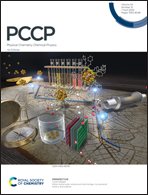Interaction of chiral l-dialanine with Cu(100)†
Abstract
We report on the properties of the thin films of the short peptide L-dialanine grown on Cu(100) surfaces and compare them to those of L-alanine by using surface techniques like XPS, IRRAS and STM. The first dialanine monolayer, in contact with the metallic substrate, is found to consist of whole neutral molecules in the non-zwitterionic state forming a c(2 × 4) pattern with quasi-hexagonal symmetry. The peptide bond of dialanine is preserved in the adsorption state. The ordering of the L-dialanine overlayer is shown to replicate rearrangements of the atoms of the substrate around dislocations of the latter indicating a strong molecule–surface interaction. In the multilayer regime, molecules of the second and further layers are found to be in a zwitterionic state, readily desorbing even at room temperature. The first dialanine layer is tightly bound to the substrate, begins to desorb at temperatures higher than 390 K and cracks down at the surface, transforming into a new moiety, beyond 435 K.



 Please wait while we load your content...
Please wait while we load your content...